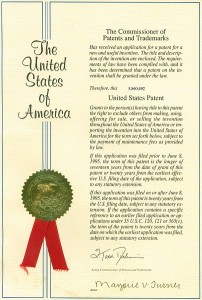 A United States patent is a property right granted from the United States government giving the inventor the right to exclude(stop) others from making, using, offering for sale or selling the patented invention in the United States for a limited period of time (usually 20 years from the filing date).
A United States patent is a property right granted from the United States government giving the inventor the right to exclude(stop) others from making, using, offering for sale or selling the patented invention in the United States for a limited period of time (usually 20 years from the filing date).
A patent is a type of intellectual property. Other types of intellectual property include: copyrights that protect the expression of an idea, trademarks that protect product and service source identifiers (brands), trade secrets that protect information and other items that have business value and are not generally known.
A patent provides a time limited monopoly over the invention in exchange for disclosing to the public the details and manner of composition of the invention. The monopoly allows you to prevent others from benefiting from your inventive work without your permission. Therefore you may be able to charge more for your product or service that is protected by a patent, than would be possible if your product was not protected and competitors copied your product and competed with you.
This exchange of a monopoly for public disclosure, allows the science area of your invention to be advanced. During and after the time when your patent is in-force others can read about the details of your invention as described in your patent, which might spark other non-infringing ideas which will advance the art/science related to your invention. Therefore you benefit from the monopoly provided by the patent and the public benefits by understanding your invention which can advance related engineering and sciences.
Maintenance fees must be paid by the patent owner at certain intervals in order to keep the patent from expiring before the patent term ends.
A U.S. patent does not provide protection outside of the country. However a U.S. patent can be used to prevent the importation of infringing products in to the United States from abroad. Foreign patents are needed to receive protection in chosen foreign countries.
